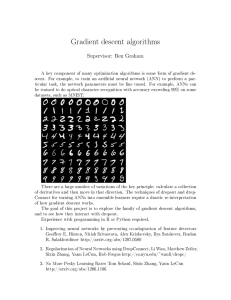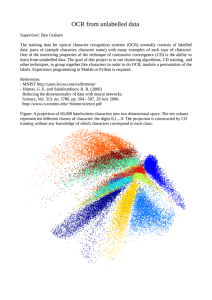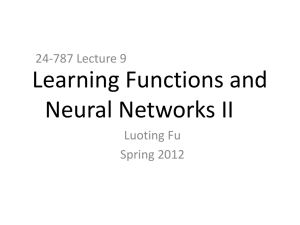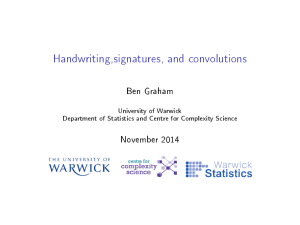Hierarchical Models Of Perception and Reasoning
advertisement
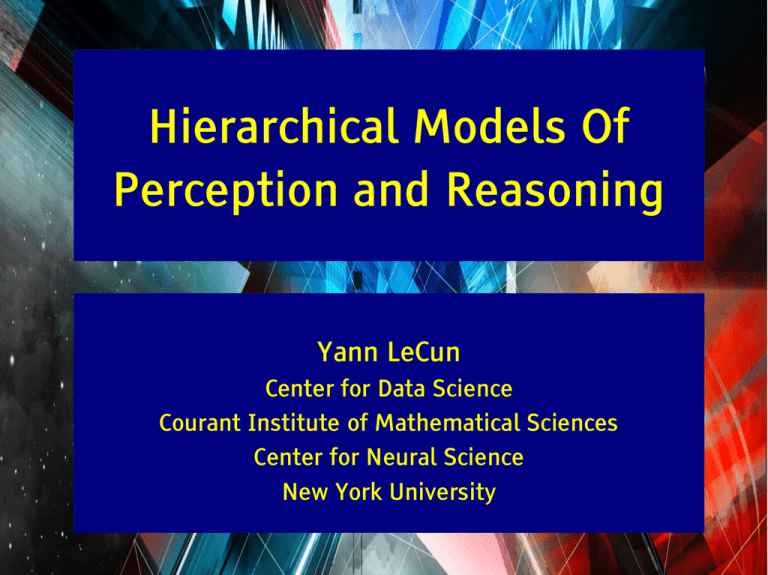
Hierarchical Models Of Perception and Reasoning Yann LeCun Center for Data Science Courant Institute of Mathematical Sciences Center for Neural Science New York University Yann LeCun Learning Representations: a challenge for Neuroscience, Cognitive Science and AI How do we learn representations of the perceptual world? How can a perceptual system build itself by looking at the world? Neuroscience: how does the cortex learn perception? Does the cortex “run” a single, general learning algorithm? AI/ML: how do we learn features or feature hierarchies? What is the learning algorithm and what is the architecture? Trainable Feature Transform Trainable Feature Transform Trainable Feature Transform Trainable Feature Deep Learning addresses the problem of learning hierarchical representations with a single algorithm (or a few) Transform Y LeCun Y LeCun Architecture of “Mainstream” Machine Learning Systems Traditional way: handcrafted features + supervised classifier (hand-crafted) “Simple” Trainable Feature Extraction Classifier Mainstream Approaches to Image and Speech Recognition Low-Level Features (fixed) MFCC SIFT HoG fixed Mid-Level Features (unsupervised) Classifier kernel (supervised) Mix of Gaussians K-means Sparse Coding unsupervised supervised Y LeCun This Basic Model has not evolved much since the 50's Built at Cornell in 1960 The Perceptron was a linear classifier on top of a simple feature extractor A The vast majority of practical applications of ML today use glorified linear classifiers Designing a feature extractor requires considerable efforts by experts. y=sign xrc eat.E F The first learning machine for perception: the Perceptron ( Wi N ∑ W i F i ( X ) +b i= 1 ) Y LeCun Models of Categorization in Psychology are equally simple Most models of perception in psychology/psychophysics are: Template/examplar/prototype based N y=sign (∑ i=1 Linear (or generalized linear) W i K ( X i ,X ) +b N y=sign (∑ i= 1 W i F i ( X ) +b ) These are simple models that are quite distant from reality They do not explain invariant recognition, crowding, or the decrease of “efficiency” with stimulus complexity [Pelli 2006] ) Y LeCun The Mammalian Visual Cortex is Hierarchical The ventral (recognition) pathway in the visual cortex has multiple stages Retina - LGN - V1 - V2 - V4 - PIT - AIT .... Lots of intermediate representations [picture from Simon Thorpe] [Gallant & Van Essen] Y LeCun Let's be inspired by nature, but not too much It's nice imitate Nature, But we also need to understand How do we know which details are important? Which details are merely the result of evolution, and the constraints of biochemistry? For airplanes, we developed aerodynamics and compressible fluid dynamics. We figured that feathers and wing flapping weren't crucial What is the equivalent of aerodynamics for understanding intelligence? L'Avion III de Clément Ader, 1897 (Musée du CNAM, Paris) His Eole took off from the ground in 1890, 13 years before the Wright Brothers, but you probably never heard of it. Y LeCun Trainable Feature Hierarchies: End-to-end learning A hierarchy of trainable feature transforms Each module transforms its input representation into a higher-level one. Trainable Trainable Trainable Feature Feature Classifier/ Transform Transform Predictor Learned Internal Representations How can we make all the modules trainable and get them to learn appropriate representations? In Many Fields, Feature Learning Has Caused a Revolution (methods used in commercially deployed systems) Y LeCun Speech Recognition I (late 1980s) Trainable mid-level features with GMM (2-layer non-linear classifier) Handwriting Recognition and OCR (late 1980s to mid 1990s) Supervised convolutional nets operating on pixels Face & People Detection (early 1990s to mid 2000s) Supervised convolutional nets operating on pixels (early 1990s) Learned Haar features (through random generation and selection, 2001) Object Recognition I (mid-to-late 2000s: Ponce, Schmid, Yu, YLC....) Trainable mid-level features (K-means or sparse coding) Speech Recognition II (circa 2011) Deep neural nets for acoustic modeling Object Recognition II, Scene Parsing (2012, Hinton, YLC,...) Supervised convolutional nets operating on pixels Y LeCun Early Hierarchical Feature Models for Vision [Hubel & Wiesel 1962]: simple cells detect local features complex cells “pool” the outputs of simple cells within a retinotopic neighborhood. “Simple cells” Multiple convolutions Cognitron & Neocognitron [Fukushima 1974-1982] “Complex cells” pooling subsampling The Convolutional Net Model Y LeCun (Multistage Hubel-Wiesel system) “Simple cells” “Complex cells” Training is supervised With stochastic gradient descent Multiple convolutions pooling subsampling [LeCun et al. 89] Retinotopic Feature Maps [LeCun et al. 98] Y LeCun Feature Transform: Normalization → Filter Bank → Non-Linearity → Pooling Norm Filter Bank NonLinear feature Pooling Norm Filter Bank NonLinear feature Pooling Classifier Stacking multiple stages of [Normalization → Filter Bank → Non-Linearity → Pooling]. Normalization: variations on whitening Subtractive: average removal, high pass filtering Divisive: local contrast normalization, variance normalization Filter Bank: dimension expansion, projection on overcomplete basis Non-Linearity: sparsification, saturation, lateral inhibition.... Rectification, Component-wise shrinkage, tanh, winner-takes-all Pooling: aggregation over space or feature type, subsampling X i; Lp: p √ X p i ; PROB : 1 log b (∑ i e bX i ) ¿ Y LeCun Feature Transform: Normalization → Filter Bank → Non-Linearity → Pooling Norm Filter Bank NonLinear feature Pooling Norm Filter Bank NonLinear feature Pooling Classifier Filter Bank → Non-Linearity = Non-linear embedding in high dimension Feature Pooling = contraction, dimensionality reduction, smoothing Learning the filter banks at every stage Creating a hierarchy of features Basic elements are inspired by models of the visual (and auditory) cortex Simple Cell + Complex Cell model of [Hubel and Wiesel 1962] Many “traditional” feature extraction methods are based on this SIFT, GIST, HoG, SURF... [Fukushima 1974-1982], [LeCun 1988-now], since the mid 2000: Hinton, Seung, Poggio, Ng,.... Y LeCun Convolutional Network (ConvNet) input 83x83 Layer 1 64x75x75 9x9 convolution (64 kernels) Layer 3 256@6x6 Layer 2 64@14x14 Layer 4 Output 256@1x1 101 9x9 10x10 pooling, convolution 5x5 subsampling (4096 kernels) 6x6 pooling 4x4 subsamp Non-Linearity: half-wave rectification, shrinkage function, sigmoid Pooling: average, L1, L2, max Training: Supervised (1988-2006), Unsupervised+Supervised (2006-now) Y LeCun Convolutional Network Architecture Y LeCun Convolutional Network (vintage 1990) filters → tanh → average-tanh → filters → tanh → average-tanh → filters → tanh Curved manifold Flatter manifold “Mainstream” object recognition pipeline 2006-2012: somewhat similar to ConvNets Filter Bank NonLinearity Oriented Winner Takes All Edges feature Pooling Histogram (sum) Fixed (SIFT/HoG/...) Filter Bank NonLinearity feature Pooling Classifier K-means Spatial Max Any simple Sparse Coding Or average classifier Unsupervised Supervised Fixed Features + unsupervised mid-level features + simple classifier SIFT + Vector Quantization + Pyramid pooling + SVM [Lazebnik et al. CVPR 2006] SIFT + Local Sparse Coding Macrofeatures + Pyramid pooling + SVM [Boureau et al. ICCV 2011] SIFT + Fisher Vectors + Deformable Parts Pooling + SVM [Perronin et al. 2012] Y LeCun Y LeCun Tasks for Which Deep Convolutional Nets are the Best Handwriting recognition MNIST (1998), Arabic HWX... OCR in the Wild (2011): StreetView House Numbers Traffic sign recognition [2011] GTSRB competition Pedestrian Detection [2013]: INRIA datasets and others Volumetric brain image segmentation [2009] (connectomics) Human Action Recognition [2011] Hollywood II dataset Scene Parsing [2012] Stanford backgrounds, SiftFlow, Barcelona datasets Object Recognition [2012] ImageNet competition Scene parsing from depth images [2013] NYU RGB-D dataset Speech Recognition [2012] Systems from IBM and Google. The list of perceptual tasks for which ConvNets hold the record is growing. Most of these tasks (but not all) use purely supervised convnets. Y LeCun Ideas from Neuroscience and Psychophysics The whole architecture: simple cells and complex cells Local receptive fields Self-similar receptive fields over the visual field (convolutions) Pooling (complex cells) Non-Linearity: Rectified Linear Units (ReLU) LGN-like band-pass filtering and contrast normalization in the input Divisive contrast normalization (from Heeger, Simoncelli....) Lateral inhibition Sparse/Overcomplete representations (Olshausen-Field....) Inference of sparse representations with lateral inhibition Sub-sampling ratios in the visual cortex between 2 and 3 between V1-V2-V4 Crowding and visual metamers give cues on the size of the pooling areas Y LeCun Simple ConvNet Applications with State-of-the-Art Performance Traffic Sign Recognition (GTSRB) House Number Recognition (Google) German Traffic Sign Reco Bench Street View House Numbers 99.2% accuracy 94.3 % accuracy Y LeCun Object Recognition [Krizhevski, Sutskever, Hinton 2012] ImageNet Large Scale Visual Recognition Challenge 1000 categories, 1.5 Million labeled training samples Method: large convolutional net 650K neurons, 630M synapses, 60M parameters Trained with backprop on GPU “with all tricks Yann came up with in the last 20 years, plus dropout” Error rate: 15% (whenever correct class isn't in top 5) Previous state of the art: 25% error A REVOLUTION IN COMPUTER VISION Y LeCun Object Recognition [Krizhevski, Sutskever, Hinton 2012] Y LeCun Object Recognition on-line demo [Zeiler & Fergus] http://horatio.cs.nyu.edu Y LeCun Labeling every pixel with the object it belongs to Would help identify obstacles, targets, landing sites, dangerous areas Would help line up depth map with edge maps [Farabet et al. ICML 2012] Y LeCun Scene Parsing/Labeling: ConvNet Architecture Each output sees a large input context: 46x46 window at full rez; 92x92 at ½ rez; 184x184 at ¼ rez [7x7conv]->[2x2pool]->[7x7conv]->[2x2pool]->[7x7conv]-> Trained supervised on fully-labeled images Categories Laplacian Pyramid Level 1 Features Level 2 Features Upsampled Level 2 Features Y LeCun Scene Parsing/Labeling: Performance Stanford Background Dataset [Gould 1009]: 8 categories [Farabet et al. IEEE T. PAMI 2012] Y LeCun Scene Parsing/Labeling: Performance SIFT Flow Dataset [Liu 2009]: 33 categories Barcelona dataset [Tighe 2010]: 170 categories. [Farabet et al. IEEE T. PAMI 2012] Y LeCun Scene Parsing/Labeling: SIFT Flow dataset (33 categories) Samples from the SIFT-Flow dataset (Liu) [Farabet et al. ICML 2012] Y LeCun Scene Parsing/Labeling: SIFT Flow dataset (33 categories) [Farabet et al. ICML 2012] Y LeCun Scene Parsing/Labeling [Farabet et al. ICML 2012] Y LeCun Scene Parsing/Labeling [Farabet et al. ICML 2012] Y LeCun Scene Parsing/Labeling [Farabet et al. 2012] Y LeCun Scene Parsing/Labeling [Farabet et al. 2012] Y LeCun Scene Parsing/Labeling No post-processing Frame-by-frame ConvNet runs at 50ms/frame on Virtex-6 FPGA hardware But communicating the features over ethernet limits system perf. Y LeCun Scene Parsing/Labeling: Temporal Consistency Majority Vote on Spatio-Temporal Super-Pixels Reset every second Y LeCun Scene Parsing/Labeling on RGB+Depth Images With temporal consistency Y LeCun Scene Parsing/Labeling on RGB+Depth Images With temporal consistency Unsupervised Learning: Disentangling the independent, explanatory factors of variation Yann LeCun Discovering the Hidden Structure in High-Dimensional Data The manifold hypothesis Learning Representations of Data: Discovering the independent explanatory factors of the data The Manifold Hypothesis: Natural data lives in a low-dimensional (non-linear) manifold Because variables in natural data are mutually dependent Y LeCun Y LeCun Discovering the Hidden Structure in High-Dimensional Data Example: all face images of a person 1000x1000 pixels = 1,000,000 dimensions But the face has 3 coordinates and 3 Euler angles And humans have less than about 50 muscles in the face Hence the manifold of face images for a person has <56 dimensions The perfect representations of a face image: Its coordinates on the face manifold Its coordinates away from the manifold We do not have good and general methods to learn from data a function that turns an image into this kind of representation Feature extractor [] 1. 2 −3 0.2 . .. Y LeCun Regularized Encoder-Decoder Model (auto-Encoder) for Unsupervised Feature Learning Encoder: computes feature vector Z from input X Decoder: reconstructs input X from feature vector Z Feature vector: high dimensional and regularized (e.g. sparse) Factor graph with energy function E(X,Z) with 3 terms: Linear decoding function and reconstruction error Non-Linear encoding function and prediction error term Pooling function and regularization term (e.g. sparsity) E ( Y,Z )=∥Y −W d Z∥2 +∥Z −g e ( W e ,Y )∥2 + ∑ j i 2 ∥Y −Ỹ ∥ INPUT k∈P j Wd Z Y λ∑ . Z g e ( W e ,Y i ) ∑ √ Z 2k √ (∑ Z2 k) FEATURES ̃ 2 ∥Z − Z∥ L2 norm within each pool Predictive PredictiveSparse SparseDecomposition Decomposition(PSD): (PSD):Training Training Training on natural images patches. 12X12 256 basis functions Yann LeCun Learned LearnedFeatures Featureson onnatural naturalpatches: patches:V1-like V1-likereceptive receptivefields fields Yann LeCun Better BetterIdea: Idea:Give Givethe the“right” “right”structure structureto tothe theencoder encoder [Gregor & LeCun, ICML 2010], [Bronstein et al. ICML 2012] ISTA/FISTA: iterative algorithm that converges to optimal sparse code INPUT Y We Lateral Inhibition Yann LeCun + sh() S Z LISTA: LISTA:Train TrainWe Weand andSSmatrices matricesto togive giveaagood goodapproximation approximationquickly quickly Think of the FISTA flow graph as a recurrent neural net where We and S are trainable parameters INPUT We Y sh() + Z S Time-Unfold the flow graph for K iterations Learn the We and S matrices with “backprop-through-time” Get the best approximate solution within K iterations Y We + Yann LeCun sh() S + sh() S Z Discriminative DiscriminativeRecurrent RecurrentSparse SparseAuto-Encoder Auto-Encoder Architecture Lateral Inhibition Decoding Filters We X Encoding Filters + () Rectified linear units S + L1 Z̄ 0 Wd X̄ X Wc Ȳ Y + () Can be repeated Classification loss: cross-entropy [Rolfe & LeCun 2013] Reconstruction loss: squared error Sparsity penalty: L1 norm of last hidden layer Rows of Wd and columns of We constrained in unit sphere Yann LeCun DrSAE DrSAEDiscovers Discoversmanifold manifoldstructure structureof ofhandwritten handwrittendigits digits Image = prototype + sparse sum of “parts” (to move around the manifold) Yann LeCun Convolutional ConvolutionalSparse SparseCoding Coding Replace the dot products with dictionary element by convolutions. Input Y is a full image Each code component Zk is a feature map (an image) Each dictionary element is a convolution kernel Regular sparse coding Convolutional S.C. Y = * ∑. k Zk Wk “deconvolutional networks” [Zeiler, Taylor, Fergus CVPR 2010] Yann LeCun Convolutional ConvolutionalPSD: PSD:Encoder Encoderwith withaasoft softsh() sh()Function Function Convolutional Formulation Extend sparse coding from PATCH to IMAGE PATCH based learning Yann LeCun CONVOLUTIONAL learning Y LeCun Convolutional Sparse Auto-Encoder on Natural Images Filters and Basis Functions obtained with 1, 2, 4, 8, 16, 32, and 64 filters. Using UsingPSD PSDto toTrain TrainaaHierarchy Hierarchyof ofFeatures Features Phase 1: train first layer using PSD ∥Y i −Ỹ ∥2 λ∑ . Wd Z Y Z g e ( W e ,Y i ) ∣z j∣ ̃ 2 ∥Z − Z∥ FEATURES Yann LeCun Using UsingPSD PSDto toTrain TrainaaHierarchy Hierarchyof ofFeatures Features Phase 1: train first layer using PSD Phase 2: use encoder + absolute value as feature extractor ∣z j∣ Y g e ( W e ,Y i ) FEATURES Yann LeCun Using UsingPSD PSDto toTrain TrainaaHierarchy Hierarchyof ofFeatures Features Phase 1: train first layer using PSD Phase 2: use encoder + absolute value as feature extractor Phase 3: train the second layer using PSD ∥Y i −Ỹ ∥2 ∣z j∣ Y g e ( W e ,Y i ) λ∑ . Wd Z Y Z g e ( W e ,Y i ) ∣z j∣ ̃ 2 ∥Z − Z∥ FEATURES Yann LeCun Using UsingPSD PSDto toTrain TrainaaHierarchy Hierarchyof ofFeatures Features Phase 1: train first layer using PSD Phase 2: use encoder + absolute value as feature extractor Phase 3: train the second layer using PSD Phase 4: use encoder + absolute value as 2 nd feature extractor ∣z j∣ Y g e ( W e ,Y i ) ∣z j∣ g e ( W e ,Y i ) FEATURES Yann LeCun Using UsingPSD PSDto toTrain TrainaaHierarchy Hierarchyof ofFeatures Features Phase 1: train first layer using PSD Phase 2: use encoder + absolute value as feature extractor Phase 3: train the second layer using PSD Phase 4: use encoder + absolute value as 2 nd feature extractor Phase 5: train a supervised classifier on top Phase 6 (optional): train the entire system with supervised back-propagation ∣z j∣ Y g e ( W e ,Y i ) ∣z j∣ classifier g e ( W e ,Y i ) FEATURES Yann LeCun Pedestrian PedestrianDetection, Detection,Face FaceDetection Detection Yann LeCun [Osadchy,Miller LeCun JMLR 2007],[Kavukcuoglu et al. NIPS 2010] Pedestrian PedestrianDetection: Detection:INRIA INRIADataset. Dataset.Miss Missrate ratevs vsfalse falsepositives positives ConvNet Color+Skip Supervised ConvNet Color+Skip Unsup+Sup Yann LeCun ConvNet B&W Unsup+Sup ConvNet B&W Supervised [Kavukcuoglu et al. NIPS 2010] [Sermanet et al. ArXiv 2012] Unsupervised Unsupervisedpre-training pre-trainingwith withconvolutional convolutionalPSD PSD 128 stage-1 filters on Y channel. Unsupervised training with convolutional predictive sparse decomposition Yann LeCun Unsupervised Unsupervisedpre-training pre-trainingwith withconvolutional convolutionalPSD PSD Stage 2 filters. Unsupervised training with convolutional predictive sparse decomposition Yann LeCun Yann LeCun Unsupervised Learning: Invariant Features Yann LeCun Y LeCun Learning Invariant Features with L2 Group Sparsity Unsupervised PSD ignores the spatial pooling step. Could we devise a similar method that learns the pooling layer as well? Idea [Hyvarinen & Hoyer 2001]: group sparsity on pools of features Minimum number of pools must be non-zero Number of features that are on within a pool doesn't matter Pools tend to regroup similar features E ( Y,Z )=∥Y −W d Z∥2 +∥Z −g e ( W e ,Y )∥2 + ∑ j i 2 ∥Y −Ỹ ∥ INPUT √∑ k∈P j Wd Z Y Z 2k λ∑ . Z 2 Z ( ∑ √ k) FEATURES g e ( W e ,Y i ) 2 ̃ ∥Z − Z∥ L2 norm within each pool Y LeCun Groups are local in a 2D Topographic Map The filters arrange themselves spontaneously so that similar filters enter the same pool. The pooling units can be seen as complex cells Outputs of pooling units are invariant to local transformations of the input For some it's translations, for others rotations, or other transformations. Y LeCun Image-level training, local filters but no weight sharing Training on 115x115 images. Kernels are 15x15 (not shared across space!) K Obermayer and GG Blasdel, Journal of Neuroscience, Vol 13, 4114-4129 (Monkey) 119x119 Image Input 100x100 Code 20x20 Receptive field size sigma=5 Michael C. Crair, et. al. The Journal of Neurophysiology Vol. 77 No. 6 June 1997, pp. 3381-3385 (Cat) Y LeCun Image-level training, local filters but no weight sharing Color indicates orientation (by fitting Gabors) Y LeCun Invariant Features Lateral Inhibition Replace the L1 sparsity term by a lateral inhibition matrix Easy way to impose some structure on the sparsity [Gregor, Szlam, LeCun NIPS 2011] Y LeCun Invariant Features via Lateral Inhibition: Structured Sparsity Each edge in the tree indicates a zero in the S matrix (no mutual inhibition) Sij is larger if two neurons are far away in the tree Y LeCun Invariant Features via Lateral Inhibition: Topographic Maps Non-zero values in S form a ring in a 2D topology Input patches are high-pass filtered Y LeCun Invariant Features through Temporal Constancy Object is cross-product of object type and instantiation parameters Mapping units [Hinton 1981], capsules [Hinton 2011] small Object type [Karol Gregor et al.] medium Object size large Y LeCun What-Where Auto-Encoder Architecture Decoder St W1 St-1 W1 Predicted input St-2 W1 W2 C1t C1t-1 C1t-2 C2t Inferred code C1t C1t-1 C1t-2 C2t Predicted code ̃1 f ∘W Encoder ̃1 f ∘W St ̃1 f ∘W St-1 f 2 ̃ W 2 ̃ ̃2 W W St-2 Input Y LeCun Low-Level Filters Connected to Each Complex Cell C1 (where) C2 (what) Generating Generatingfrom fromthe theNetwork Network Input Yann LeCun Challenges Yann LeCun Y LeCun The Graph of Deep Learning ↔ Sparse Modeling ↔ Neuroscience Compr. Sensing Basis/Matching Pursuit Stochastic Optimization [Mallat 93; Donoho 94] [Nesterov, Bottou L2-L1 optim [Nesterov, Neocognitron Sparse Modeling Backprop [Olshausen-Field 97] [many 85] Nemirovski Sparse Modeling Daubechies, [Bach, Sapiro. Elad] Osher....] [Hubel, Wiesel 62] Nemirovski,....] [Candès-Tao 04] Architecture of V1 [Fukushima 82] Convolutional Net [LeCun 89] MCMC, HMC Scattering Transform [Mallat 10] Normalization Cont. Div. Restricted [Neal, Hinton] Sparse Auto-Encoder Boltzmann [LeCun 06; Ng 07] Machine Object Reco [LeCun 10] [Hinton 05] [Simoncelli 94] Visual Metamers [Simoncelli 12] Speech Recognition Object Recog Scene Labeling Connectomics [Goog, IBM, MSFT 12] [Hinton 12] [LeCun 12] [Seung 10] Y LeCun Integrating Feed-Forward and Feedback Marrying feed-forward convolutional nets with generative “deconvolutional nets” Deconvolutional networks [Zeiler-Graham-Fergus ICCV 2011] Trainable Feature Transform Trainable Feature Feed-forward/Feedback networks allow reconstruction, multimodal prediction, restoration, etc... Deep Boltzmann machines can do this, but there are scalability issues with training Transform Trainable Feature Transform Trainable Feature Transform Y LeCun Integrating Deep Learning and Structured Prediction Deep Learning systems can be assembled into factor graphs Energy function is a sum of factors E(X,Y,Z) Factors can embed whole deep learning systems X: observed variables (inputs) Energy Model Z: never observed (latent variables) (factor graph) Y: observed on training set (output variables) Inference is energy minimization (MAP) or free energy minimization (marginalization) over Z and Y given an X Z (unobserved) X Y (observed) (observed on training set) Y LeCun Integrating Deep Learning and Structured Prediction Deep Learning systems can be assembled into factor graphs F(X,Y) = Marg_z E(X,Y,Z) Energy function is a sum of factors E(X,Y,Z) Factors can embed whole deep learning systems X: observed variables (inputs) Energy Model Energy graph) Model (factor Z: never observed (latent variables) (factor graph) Y: observed on training set (output variables) Inference is energy minimization (MAP) or free energy minimization (marginalization) over Z and Y given an X Z (unobserved) F(X,Y) = MIN_z E(X,Y,Z) F(X,Y) = -log SUM_z exp[-E(X,Y,Z) ] X Y (observed) (observed on training set) Y LeCun Integrating Deep Learning and Structured Prediction Integrting deep learning and structured prediction is a very old idea In fact, it predates structured prediction Globally-trained convolutional-net + graphical models trained discriminatively at the word level Loss identical to CRF and structured perceptron Compositional movable parts model A system like this was reading 10 to 20% of all the checks in the US around 1998 Y LeCun Integrating Deep Learning and Structured Prediction Deep Learning systems can be assembled into factor graphs F(X,Y) = Marg_z E(X,Y,Z) Energy function is a sum of factors E(X,Y,Z) Factors can embed whole deep learning systems X: observed variables (inputs) Energy Model Energy graph) Model (factor Z: never observed (latent variables) (factor graph) Y: observed on training set (output variables) Inference is energy minimization (MAP) or free energy minimization (marginalization) over Z and Y given an X Z (unobserved) F(X,Y) = MIN_z E(X,Y,Z) F(X,Y) = -log SUM_z exp[-E(X,Y,Z) ] X Y (observed) (observed on training set) Y LeCun Future Challenges Integrated feed-forward and feedback Deep Boltzmann machine do this, but there are issues of scalability. Integrating supervised and unsupervised learning in a single algorithm Again, deep Boltzmann machines do this, but.... Integrating deep learning and structured prediction (“reasoning”) This has been around since the 1990's but needs to be revived Learning representations for complex reasoning “recursive” networks that operate on vector space representations of knowledge [Pollack 90's] [Bottou 2010] [Socher, Manning, Ng 2011] Representation learning in natural language processing [Y. Bengio 01],[Collobert Weston 10], [Mnih Hinton 11] [Socher 12] Better theoretical understanding of deep learning and convolutional nets e.g. Stephane Mallat's “scattering transform”, work on the sparse representations from the applied math community....
